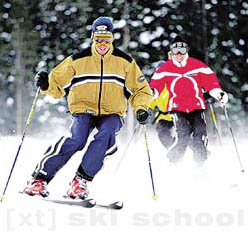|
Bindings: Don't break your leg
The binding is the mechanism that holds your boot to the ski. there are several types available on the market and all having their own pros and cons. The problematic bindings are made of metal with composite accessories. These parts seem to fall off or break with surprising regularity, and even though they will be fixed by the companies, it is a pain to remove the binding and send it back to the company mid-season. Ask the local ski shop tech guys for a good binding. They will usually know the problem models out that season. Just an observation, the guys at the big chain shops sell bikes one day and skis the next. Chances are, they don't know any more about skis and binding htan you do. Go to the small specialty shops. The next consideration: make sure your binding has the right DIN settings for your weight. DIN stands for Deuche International Number, a standard for ski bindings. It indicates the amount of torque necessary to release from the binding. This setting is crucially important. As a beginner, you will have all types of falls, from twisting, knee wrenching falls to hamstring stretching forward crashes. The DIN setting on your binding should always be professionally set. It will save an injury. If you are a heavyweight or an expert, make sure the DIN goes high enough. The pros use a DIN range of 14-24.
Alpine Skiing School section in english version of WWW.SKI.BG is based on
"A Guide To Becoming An Expert: From First Time To A Lifetime"
by John Mukavitz Copyright © 1998

|


